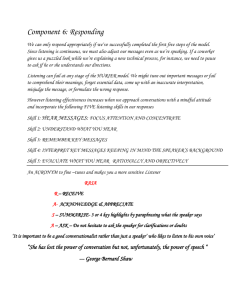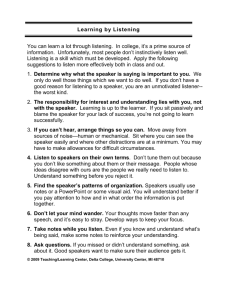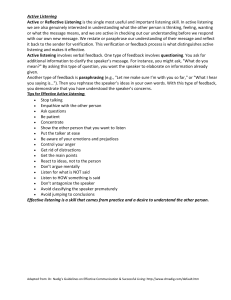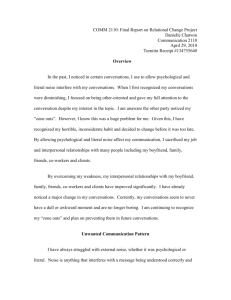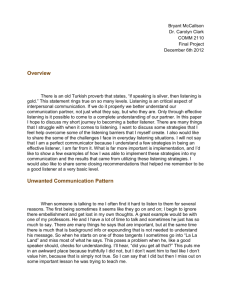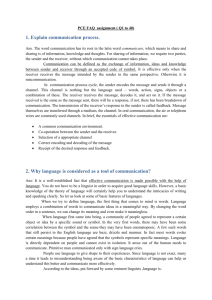Study Guide
advertisement
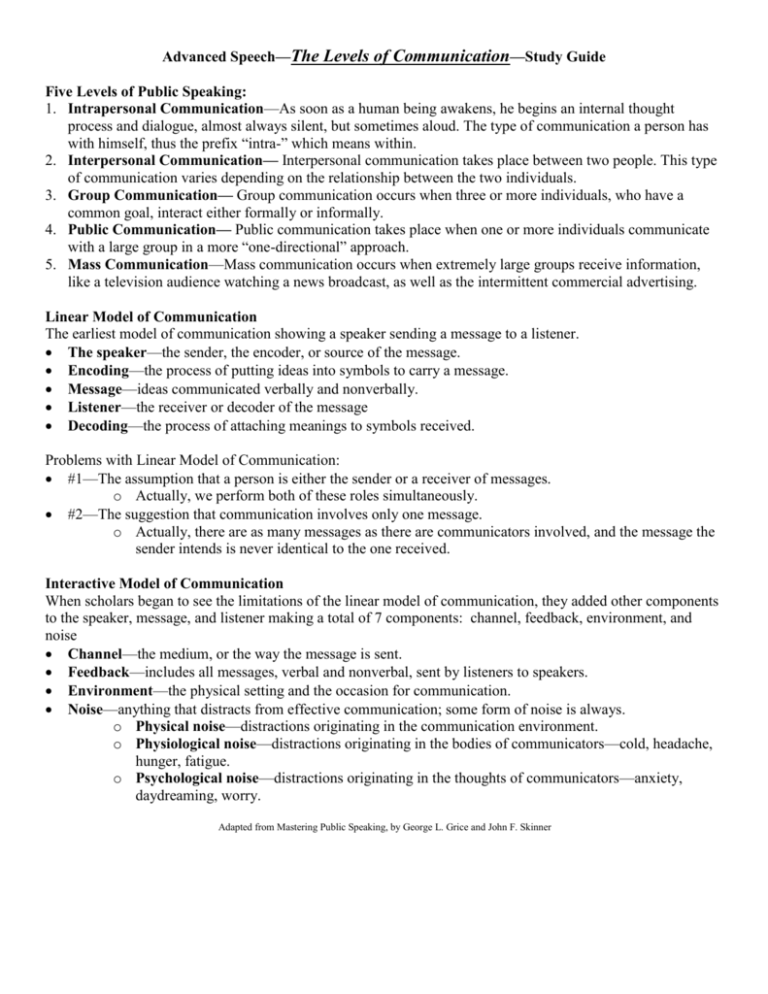
Advanced Speech—The Levels of Communication—Study Guide Five Levels of Public Speaking: 1. Intrapersonal Communication—As soon as a human being awakens, he begins an internal thought process and dialogue, almost always silent, but sometimes aloud. The type of communication a person has with himself, thus the prefix “intra-” which means within. 2. Interpersonal Communication— Interpersonal communication takes place between two people. This type of communication varies depending on the relationship between the two individuals. 3. Group Communication— Group communication occurs when three or more individuals, who have a common goal, interact either formally or informally. 4. Public Communication— Public communication takes place when one or more individuals communicate with a large group in a more “one-directional” approach. 5. Mass Communication—Mass communication occurs when extremely large groups receive information, like a television audience watching a news broadcast, as well as the intermittent commercial advertising. Linear Model of Communication The earliest model of communication showing a speaker sending a message to a listener. The speaker—the sender, the encoder, or source of the message. Encoding—the process of putting ideas into symbols to carry a message. Message—ideas communicated verbally and nonverbally. Listener—the receiver or decoder of the message Decoding—the process of attaching meanings to symbols received. Problems with Linear Model of Communication: #1—The assumption that a person is either the sender or a receiver of messages. o Actually, we perform both of these roles simultaneously. #2—The suggestion that communication involves only one message. o Actually, there are as many messages as there are communicators involved, and the message the sender intends is never identical to the one received. Interactive Model of Communication When scholars began to see the limitations of the linear model of communication, they added other components to the speaker, message, and listener making a total of 7 components: channel, feedback, environment, and noise Channel—the medium, or the way the message is sent. Feedback—includes all messages, verbal and nonverbal, sent by listeners to speakers. Environment—the physical setting and the occasion for communication. Noise—anything that distracts from effective communication; some form of noise is always. o Physical noise—distractions originating in the communication environment. o Physiological noise—distractions originating in the bodies of communicators—cold, headache, hunger, fatigue. o Psychological noise—distractions originating in the thoughts of communicators—anxiety, daydreaming, worry. Adapted from Mastering Public Speaking, by George L. Grice and John F. Skinner Three Levels of Listening Level 1: Empathetic Listening. At this level, listeners refrain from judging the talker and place themselves in the other’s position, attempting to see things from his or her point of view. The overall focus is to listen from the heart, which opens the doorway to understanding, caring, and empathy. Level 2: Hearing words, but not really listening. At this level, people stay at the surface of the communication and do not understand the deeper meanings of what is being said. They try to hear what the speaker is saying but make little effort to understand the speaker’s intent. At Level 2, the speaker may be lulled into a false sense of being listened to and understood. Level 3: Listening in spurts. Tuning in and tuning out, being somewhat aware of others, but mainly paying attention to oneself. One follows the discussion only enough to get a chance to talk. Often a person listening at this level is faking attention while thinking about unrelated matters, making judgments, forming rebuttals, or advice, or preparing what he or she wants to say next. The listener may display a blank stare and is more interested in talking than listening. (14) Most of us listen at all three levels during the course of a day. However, the goal is to listen at level 1 in all situations. (14) To do well on the upcoming test, review all PowerPoint presentations, and be able to list and explain important terms. ~~~~~~~~~~~~~~~ Advanced Speech—TheTest Communication—History, Levels of Public Speaking, and Listening Please answer the following questions as thoroughly as possible (using complete sentences), including important terminology, clearly indicating you have a complete understanding of the concepts we have discussed. 1. 2. 3. 4. 5. 6. Briefly discuss the history of communications. List and explain the five levels of Public Speaking. Explain the Linear Model of Communication. Discuss the problems with the Linear Model of Communication. Explain the Interactive Model of Communication. List and explain the Three Levels of Listening.


